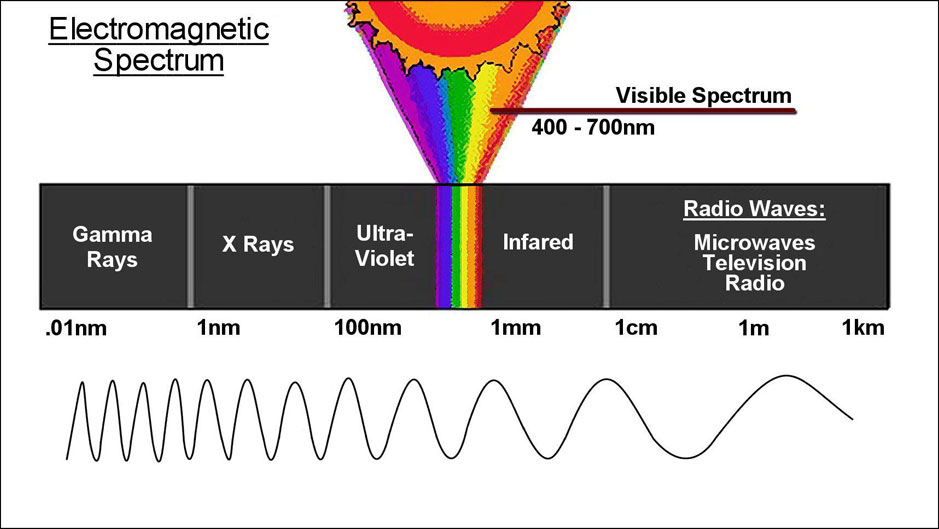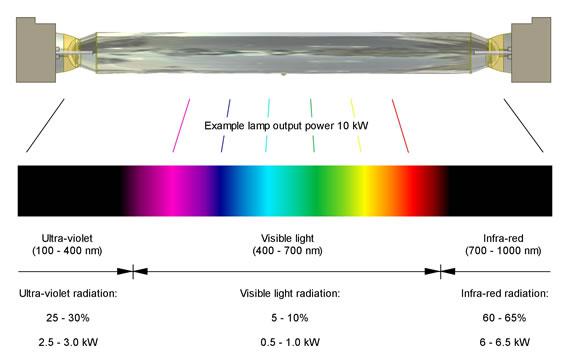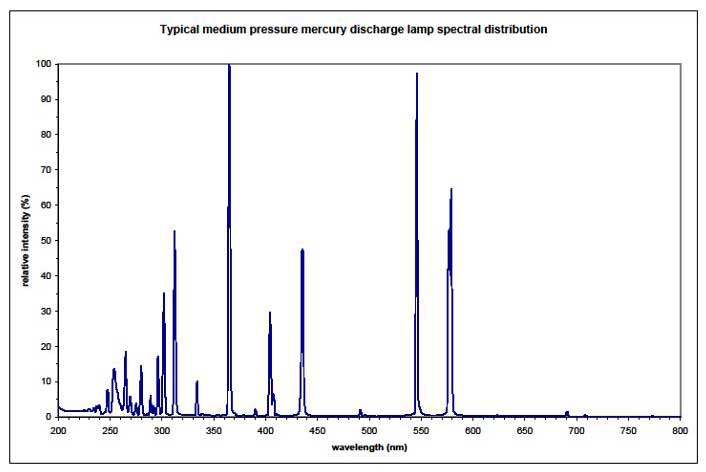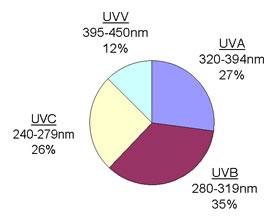What is UV?
Ultraviolet (UV) radiation is electromagnetic radiation of a wavelength shorter than that of the visible region and longer than that of X-rays.
As air is opaque to UV radiation of less than 200nm wavelength, it is often subdivided into:
- near UV (380-200nm wavelength),
- extreme or vacuum UV (200-10nm).
More commonly, when used in connection with human health and the environment, it is subdivided into:
UVA (380-315 nm),
UVB (315-280 nm),
UVC (280-10 nm).
In respect of UV curing there is also UVV (UV visible, 450-395nm). As the name suggests, UVV extends into the visible light spectrum.

Spektrum elektromagnetyczne
What produces UV?
The Sun emits a vast range of electromagnetic radiation with approximately 10% of that energy in the ultraviolet region. Here on Earth we are protected to some extent by the ozone layer which absorbs UV to the extent that 99% of the ultraviolet radiation reaching the Earth’s surface is UVA. Ozone is, in fact, produced by the interaction of UVC with the atmosphere. UV is also produced by photocopiers, photographic flashes and arc-welding. Manufactured light sources are LED’s, arc lamps and microwave lamps.
How does GEW produce UV?
GEW use mostly medium pressure mercury arc lamps.
How does a mercury arc lamp work?
A mercury arc lamp, broadly speaking, is constructed of a long sealed quartz tube which is filled with a starting gas and a small amount of mercury and has an electrode at each end.
When a voltage is applied between the electrodes, the starting gas ionizes and starts to heat up. The hot gas evaporates the mercury which then emits radiation, a proportion of which is in the UV range.

Typical medium pressure mercury discharge lamp power distribution
Why use mercury?
The majority of current inks and coatings are cured by exposure to energy at the 254nm and 365nm regions. This corresponds with the natural spectral output of an undoped mercury arc lamp as shown below.
Some new coatings and special applications call for other wavelengths such as 385nm and 417nm. These and other radiation bands can be created by the addition of metal halides. The output from a typical medium pressure mercury discharge lamp spectral distribution is shown below.

Typical medium pressure mercury discharge lamp spectrum distribution

- UVV – For the curing of thick layers.
- UVA – For heavier ink coats, i.e. silk screen.
- UVB – For through cure on flexo-printing / general ink surface hardening.
- UVC – For surface cure / touch cure.
What is UV curing?
Conventional inks and coatings (water or solvent based) are dried through an evaporation process which removes approximately 40% of the delivered ink volume.
UV curing inks and coatings contain a “photoinitiator” which is a special compound sensitive to UV radiation. Its exposure to intense UV radiation initiates a rapid catalytic reaction in the ink or coating, transforming it from liquid to solid state as a crosslinked polymer network. Solvents are not required for this process; the product is cured rather than dried. Consequently there is no loss of volume.
Why use UV curing?
From a quality perspective, UV inks and coatings have excellent chemical, abrasion and heat resistance. The high solids content gives greater consistency of viscosity and colour, provides for a very high gloss finish and gives better consistency between substrates. With UV flexo-inks offering a sharper dot structure, an altogether superior finish can be achieved.
As UV inks and coatings do not dry until they are cured, there is no need to wash-down machines at the end of shifts or between runs. Wash-downs tend to be quicker and easier too as there will be no dried on contaminants and no cell plugging of anilox rollers. As a result, machine utilization will be greatly improved and, with no evaporative losses, ink consumption will be reduced. The reduced curing times enable high production speeds and immediate post processing (stacking, folding, polishing etc).
Energy efficiency will be greatly improved as the UV lamphead focuses the energy exactly where it is needed, at the substrate surface. Inefficient power-hungry conventional heater/dryers are no longer required. With less heat generated, the more heat-sensitive substrates can be processed. Space efficiency is often an important factor. UV dryers are generally much more compact than conventional heater/dryers.
The benefits extend to the press crew too. Machine operators generally prefer working with UV curing systems as they provide a better, safer and healthier working environment. As typical UV formulations do not contain solvents and volatile organic compounds (VOCs) , the considerable health risks associated with vapour inhalation are eliminated. Not only that, the environment benefits too. With less frequent wash-downs and better printing consistency, presswork becomes altogether easier.